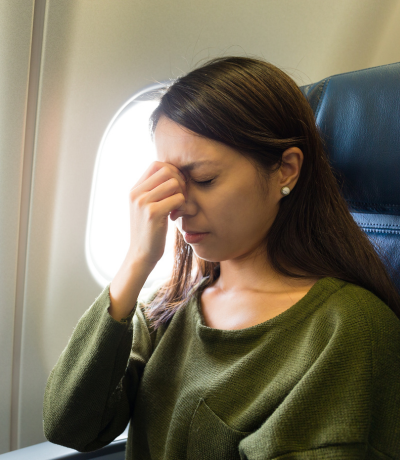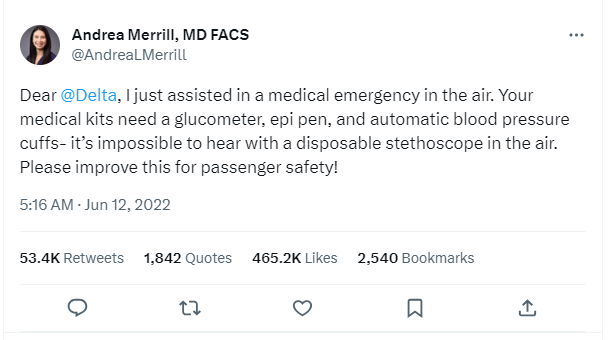How to avoid an in-flight medical emergency on your next trip
20 July 2023
Your upcoming trip should be a smooth and enjoyable experience, but unexpected medical emergencies can arise anytime.
Here are just a few examples from recent news stories of travel medical emergencies:
- A healthy young traveler from the US visits Mexico, takes an e-bike for a cruise, and hit a speed bump in the road. The resulting crash causes a severe head injury and road rash across her body.
- An American citizen and retired teacher with Swiss health insurance has a burst appendix while attending his only daughter’s wedding.
- A traveler on a flight from Atlanta to Seoul goes pale and passes out, experiencing a mid-air heart attack.
Stories like this are every traveler’s worst nightmare, but medical emergencies occur anywhere and without warning. With so many people traveling, more than ever since the pandemic, how do you keep a medical emergency from ruining your next flight?
In this article, I’ll share essential tips and precautions to help you prevent and handle inflight medical emergencies.

Don’t fly when you’re sick or have symptoms
If the pandemic taught us anything, it’s not to ignore mild symptoms like a stuffy nose, itchy throat, or shortness of breath. It’s not just about your health, it’s about the health of others around you.
Still, flying while you’re sick can make your symptoms worse:
- If you’re congested, you may not be able to equalize the pressure in the tubes connecting your sinuses and Eustachian tubes. This can lead to severe pain that can last long after your flight. It can also cause trouble with hearing, vertigo, and even eardrum damage.
- If you’re feeling short of breath, the lower oxygen levels in flight could impair your ability to oxygenate your blood and lead to fainting.
- If you have a sore or itchy throat, the low humidity can increase the irritation of your mucus membranes and worsen your throat condition.
It’s a challenge for every traveler to stay hydrated while flying, and when you’re sick, dehydration can lead to lightheadedness, nausea, and dizzy spells.
Flying when you’re sick can be more risky than you think!
Don’t rely on flight crews
Airlines are used to seeing medical emergencies from vomiting to allergic reactions—they’ve seen it all.
Flight attendants are trained in basic first aid, CPR, and the use of automated external defibrillators (AEDs). They have medical kits with basic supplies and strategies for handling urgent-care situations.
Those medical kits are bare-bones, and the equipment isn’t state-of-the-art. Calling for medical help in-flight is not the same as having a paramedic with all the latest and greatest supplies, for example.
Doctors and medical organizations have been urging the FAA to require aircraft to carry EpiPens, for example. One doctor, who assisted with a medical emergency on a Delta flight in June 2022, tweeted:

Key takeaway: Flights crews are prepared, but you can’t count on the airlines to have everything you might need for an in-flight medical emergency.
Don’t ignore the risks
Depending on how healthy you are, where you’re headed, and what activities you’ll be doing when you travel, you have to pay attention to the risks.
- If you recently underwent surgical treatment, you should be extra aware and cautious about traveling. Gas expands when flights are ascending, which can lead to post-surgery complications.
- Hikers or bikers who break ribs or puncture lungs during a nasty tumble may be prone to tension pneumothorax, a potentially fatal condition.
- Scuba divers should wait at least 24 hours after their last dive before flying to avoid the bends, or decompression sickness.
Common summer travel emergencies include heat stroke, sunburns, insect-born viruses (malaria, dengue, and zika), and head injuries from motorized and non-motorized vehicle crashes. Some new threats have appeared lately, including tick-borne encephalitis in forested areas of Europe, which can be prevented with a vaccine.
Don’t just show up and hop on the flight; think about the potential health risks you could face.
Be prepared
When it comes to avoiding an in-flight medical emergency, you are the best advocate for yourself and your family. Have your own first-aid kit with the basics for everything from headaches to dehydration to cuts.
- Customize your first-aid kit with the ‘extras’ you know you might need, like an EpiPen (or a few, in case someone else needs it).
- Tuck a list of your medications and the emergency numbers to your doctors into the emergency kit too.
- Don’t forget to pack your medications in your carry-on, not your checked bag.
See What’s in Your Travel Medical Kit for a list of items to include.
Take action onboard
When it comes to avoiding an in-flight medical emergency, you can do a lot while in flight to take charge of your health.
- To avoid blood clots and other possible medical issues, stand up and stretch fully every hour or so. Wiggle your toes, reach your arms above your head, and pull your knees into your chest.
- Hydrate often with water (not caffeinated, sugary, or alcoholic beverages). A good rule of thumb to know you’re hydrated enough is when you need to pee at least every hour or two.
See Pain-free flights: how to avoid aches and pains on long flights for useful inflight strategies.
Related topics
Damian Tysdal is the founder of CoverTrip, and is a licensed agent for travel insurance (MA 1883287). He believes travel insurance should be easier to understand, and started the first travel insurance blog in 2006.
